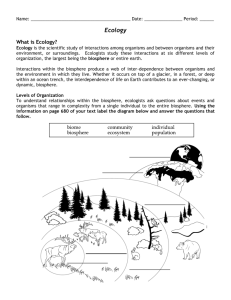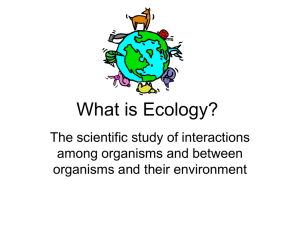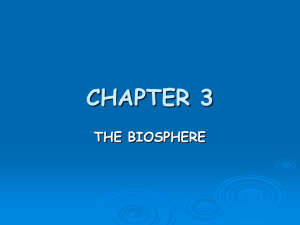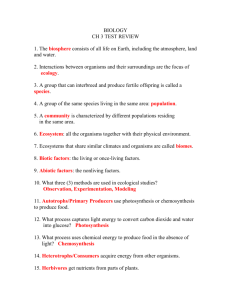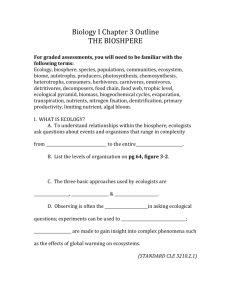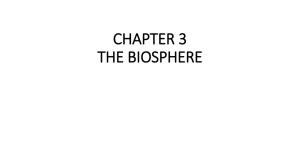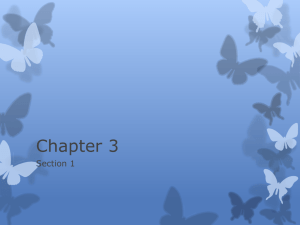The Biosphere – Ch
advertisement
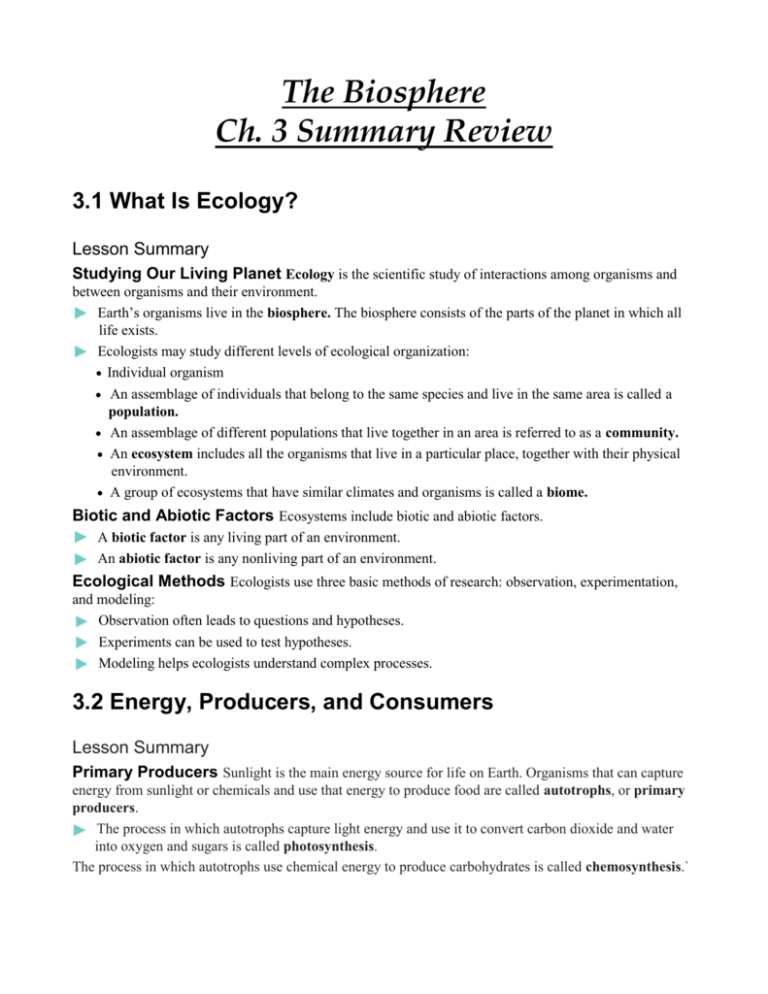
The Biosphere Ch. 3 Summary Review 3.1 What Is Ecology? Lesson Summary Studying Our Living Planet Ecology is the scientific study of interactions among organisms and between organisms and their environment. Earth’s organisms live in the biosphere. The biosphere consists of the parts of the planet in which all life exists. Ecologists may study different levels of ecological organization: Individual organism An assemblage of individuals that belong to the same species and live in the same area is called a population. An assemblage of different populations that live together in an area is referred to as a community. An ecosystem includes all the organisms that live in a particular place, together with their physical environment. A group of ecosystems that have similar climates and organisms is called a biome. Biotic and Abiotic Factors Ecosystems include biotic and abiotic factors. A biotic factor is any living part of an environment. An abiotic factor is any nonliving part of an environment. Ecological Methods Ecologists use three basic methods of research: observation, experimentation, and modeling: Observation often leads to questions and hypotheses. Experiments can be used to test hypotheses. Modeling helps ecologists understand complex processes. 3.2 Energy, Producers, and Consumers Lesson Summary Primary Producers Sunlight is the main energy source for life on Earth. Organisms that can capture energy from sunlight or chemicals and use that energy to produce food are called autotrophs, or primary producers. The process in which autotrophs capture light energy and use it to convert carbon dioxide and water into oxygen and sugars is called photosynthesis. The process in which autotrophs use chemical energy to produce carbohydrates is called chemosynthesis.` Consumers Organisms that rely on other organisms for their energy and food are called heterotrophs. Heterotrophs are also referred to as consumers. There are many different types of heterotrophs: Herbivores, such as cows, obtain energy by eating only plants. Carnivores, such as snakes, eat only animals. Omnivores, such as humans, eat both plants and animals. Detritivores, such as earthworms, feed on dead matter. Decomposers, such as fungi, break down organic matter. Scavengers, such as vultures, consume the carcasses of other animals. 3.3 Energy Flow in Ecosystems Lesson Summary Food Chains and Food Webs Energy flows through an ecosystem in one direction from primary producers to various consumers. A food chain is a series of steps in which organisms transfer energy by eating and being eaten. Producers, such as floating algae called phytoplankton, are at the base of every food chain. A food web is a network of all the food chains in an ecosystem. Food webs are very complex. Small disturbances to one population can affect all populations in a food web. Changes in populations of zooplankton, small marine animals that feed on algae, can affect all of the animals in the marine food web. Trophic Levels and Ecological Pyramids Each step in a food chain or food web is called a trophic level. Producers make up the first trophic level. Consumers make up higher trophic levels. Each consumer depends on the trophic level below it for energy. An ecological pyramid is a diagram that shows the relative amounts of energy or matter contained within each trophic level in a food chain or food web. Types of ecological pyramids are pyramids of energy, pyramids of biomass, and pyramids of numbers: Pyramids of energy show relative amounts of energy available at different trophic levels. Pyramids of biomass show the total amount of living tissue at each trophic level. A pyramid of numbers shows the relative numbers of organisms at different trophic levels. 3.4 Cycles of Matter Lesson Summary Recycling in the Biosphere Matter, unlike energy, is recycled within and between ecosystems. Elements pass from one organism to another and from one part of the biosphere to another through biogeochemical cycles, which are closed loops powered by the flow of energy. The Water Cycle Water moves between the ocean, the atmosphere, and land. Evaporation is the process in which water changes from a liquid to a gas. Transpiration is the process in which water evaporates from the leaves of plants. Nutrient Cycles The chemical substances that an organism needs to survive are called nutrients. Like water, nutrients pass through organisms and the environment. Carbon Cycle: Carbon is a key ingredient of all organic compounds. Processes involved in the carbon cycle include photosynthesis and human activities such as burning. Nitrogen Cycle: Nitrogen is needed by all organisms to build proteins. Processes involved in the nitrogen cycle include nitrogen fixation and denitrification. In nitrogen fixation, certain bacteria convert nitrogen gas into ammonia. In denitrification, other soil bacteria convert nitrogen compounds called nitrates back into nitrogen gas. Phosphorus Cycle: Phosphorus is needed for molecules such as DNA and RNA. Most of the phosphorus in the biosphere is stored in rocks and ocean sediments. Stored phosphorus is gradually released into water and soil, where it is used by organisms. Nutrient Limitation A nutrient that, in short supply, can limit the productivity of an ecosystem is called a limiting nutrient.

